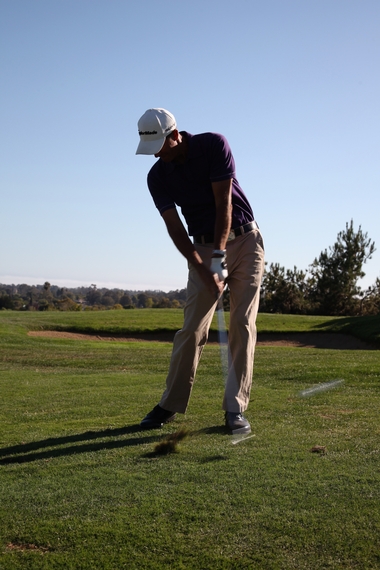
Cure many other common faults and leave your student’s uniqueness by showing them the proper impact.
Have you ever wondered while working with your students, “How in the world did they ever get into that position?” Well, if you have, I recommend that you ask he or she to show you what impact position is to them. I have found that a majority, I mean almost 99% of all golfers, would not even come close to the proper impact position. Their ideas would range from showing impact as address, to really not knowing the position at all. It becomes worse when a student is asked to show a motion from the top of the swing down to the ball and then stop abruptly at impact. Half the time the club would not even be on the ground behind the ball. Therefore, if the student is unable to even show impact when he tries to make a golf swing, most likely he will make a motion that is incorrect based on a feel of what he thinks is the impact position.
Impact position is the moment of truth. It is what will send the ball in the appropriate direction with its relative height and distance based on club selection. Mr. Ben Hogan always said, “If you have control of your trajectory, you have control of you swing.” If that is true, we must be able to show our students the correct impact position. Showing the student the proper impact literally means posing in the position. In turn, with training the student must be able to demonstrate the proper impact position to succeed in consistency.
The key to impact is being able to show your students the shift from address to impact. The shift works like this. From address, push your hands forward and higher so the shaft starts to become more perpendicular to the ground with the toe of the clubface turning closed or in with the ball centered in the sweet spot. The sensation or feel of this would be a closing clubface while the hands push forward and away from the body without the clubface moving forward at all. Again, the movement from address to impact consists of these four elements:
- Hands are leading.
- Shaft becomes more vertical.
- Clubface closes as the shift occurs.
- Clubface remains positioned behind the ball in the sweet spot.
Again, these are only stagnant positions shown from address to impact. After your students can see and produce this correct action ask them to swing to the top and come back down to the proper impact and stop. With practice, the student will be able to perform this at a fairly good pace. As an instructor, you will find that some of their pervious flaws in the golf swing will not be apparent. The golfer has adjusted to the correct impact position which changes the entire motion of the golf swing. Now that their impact is correct, their individuality and uniqueness would come forth with changes to suit the impact position that produces the correct ball flight.
Here are some common faults of the full swing that could change automatically because the student knows the proper impact. Take for example “coming over the top.” The club shaft will learn to release from behind and underneath the hands, not outside them. Because he or she trusts the clubface will be square at impact, the student will have no intention of throwing the club head outside the line, but rather working on plane into the vertical shaft position at impact. Another fault is not being able to tuck the back elbow in on the downswing. With the shaft moved to a more vertical impact position, the elbow will always appear in and under from the back view. This shows that the back elbow is a product of the shaft position, not a position trying to be created by the student. Visualize it like this. A shaft too low or angled more horizontal to the ground with the back elbow into the side creates the illusion that the elbow is out and over the shaft line. Basically the hands are too low at impact. One final fault is lifting up at the point of contact resulting in the dreaded “skull” or “top”. This occurs as the golfer feels he or she has to get the ball in the air. This feel often causes the lead wrist to cup at impact. This in effect shortens the radius of the arch and starts moving the club head upwards and away from contacting the ball. With the hands leading at impact, the student is able to feel the hands staying in the hitting area, keeping his body in the shot longer. Also, because the shaft becomes more vertical at impact, the uncocking of the wrist will be downwards, striking the ball on a descent which will get the ball airborne.
As an instructor for many years, I have learned to appreciate the many different and unique swings that manage to hit the little white ball in a consistent fashion. From Nick Faldo to Fred Couples or Jim Furyk to Tiger Woods, their personalities are apparent in their swings. Try to keep your students individuality by letting their feels adapt to the correct impact position. Then they might just hit that little white ball like the pros.
Source
1998 National PGA Magazine
